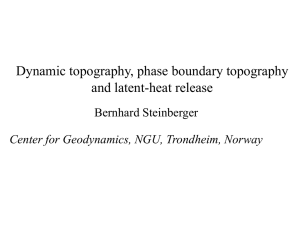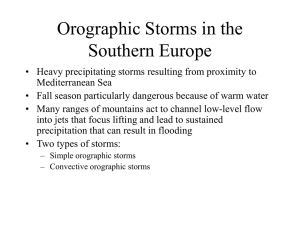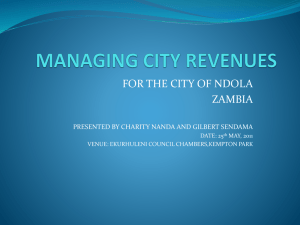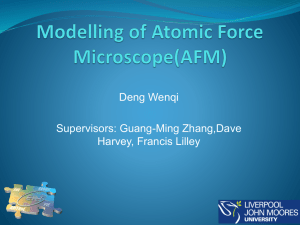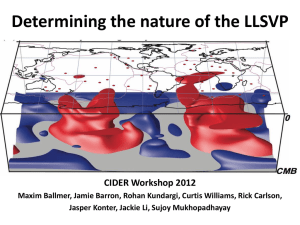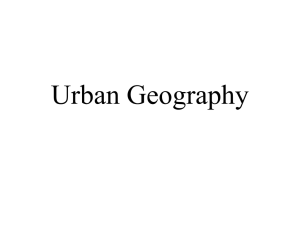dynto10
advertisement
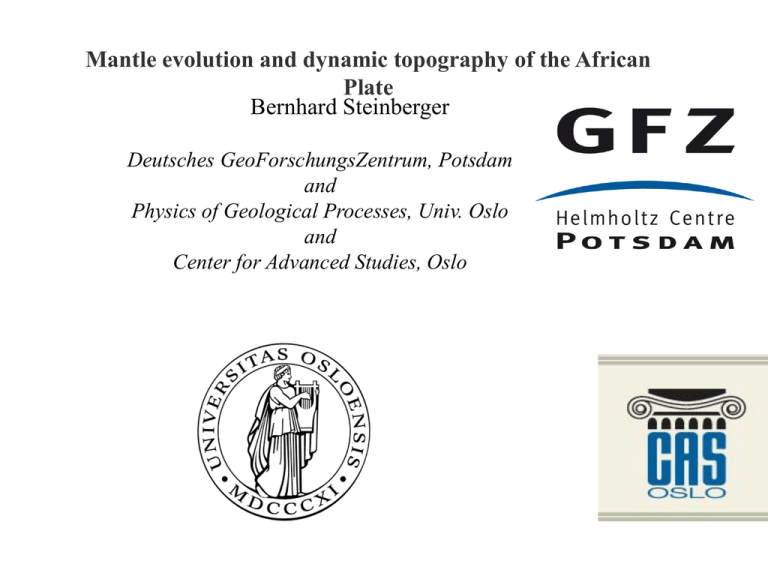
Mantle evolution and dynamic topography of the African Plate Bernhard Steinberger Deutsches GeoForschungsZentrum, Potsdam and Physics of Geological Processes, Univ. Oslo and Center for Advanced Studies, Oslo Motivation Understanding the mantle contribution to surface uplift and subsidence over time on a large scale •Dynamic topography influences which regions are below sea level, and at what depth, and therefore where sediments and related natural resources may form •Before attempting to compute uplift and subsidence in the geologic past, we must first understand present-day dynamic topography Present-day topography •Dynamic topography influences which regions are below sea level, and at what depth, and therefore where sediments and related natural resources may form •Before attempting to compute uplift and subsidence in the geologic past, we must first understand present-day dynamic topography Present-day topography + 200 m •Dynamic topography influences which regions are below sea level, and at what depth, and therefore where sediments and related natural resources may form •Before attempting to compute uplift and subsidence in the geologic past, we must first understand present-day dynamic topography Present-day topography minus 200 m Outline Mantle flow models based on seismic tomography Dynamic topography for present-day – computation and comparision with observations Inferring uplift and subsidence in the past from backward-advection of density anomalies and plate reconstructions Seismic tomography S-wave models (here: tx2007 of Simmons, Forte and Grand) Seismic tomography S-wave models (here: tx2007 of Simmons, Forte and Grand) • Conversion factor ~ 0.25 (Steinberger and Calderwood, 2006) – 4 % velocity variation ~ ~ 1 % density variation Remove lithosphere Seismic tomography Converted to density anomalies •Conversion factor ~ 0.25 (Steinberger and Calderwood, 2006) – 4 % velocity variation ~ 1 % density variation Remove lithosphere Computation of dynamic topography •radial viscosity structure based on mineral physics and optimizing fit to geoid etc. (Steinberger and Calderwood, 2006) •Computation of dynamic topography through topography kernels (above: stressfree upper boundary; below: normal-stressfree with zero horizontal motion) Actual topography What to compare computations to for present-day Actual topography MINUS Isostatic topography What to compare computations to for present-day Actual topography What to compare computations to for present-day Non-isostatic topography MINUS Isostatic topography = Comparision non-isostatic vs. dynamic topography TX2007 tomography Lithosphere removed (cutoff 0.2%) Non-isostatic topography What to compare computations to for present-day Non-isostatic topography MINUS Thermal topography What to compare computations to for present-day Non-isostatic topography What to compare computations to for present-day residual topography MINUS Thermal topography = Comparision residual vs. dynamic topography TX2007 tomography Lithosphere removed (cutoff 0.2%) Sea floor cooling removed Comparision residual vs. dynamic topography TX2007 tomography Lithosphere not removed Sea floor cooling removed Correlation and ratio of dynamic vs. residual topography Best fit (in terms of variance reduction) Ratio on African plate Ratio globally Correlation on African plate Correlation globally Correlation and ratio of dynamic vs. residual topography Best fit (in terms of variance reduction) Ratio on African plate Ratio globally Correlation on African plate Correlation globally Further improvements by combination with surface tomography models, or ... Correlation and ratio of dynamic vs. residual topography PRI-P05 Ratio globally Best fit (in terms of variance reduction) PRIS05 Ratio on African plate Correlation on African plate Correlation globally Mixing tomography models – here: Princeton P and S models TOPOS362D1 J362D28-P 4 6 Harvard Princeton PRI-S05 PRI-P05 6 4 2 8 East SAW24B16 SAW642AN 4 6 TX2007 S20RTS 9 1 Berkeley «smean» 7 3 West 6 4 Further improvements possible by using other lithosphere models Best results when using lithosphere thicknesses from Rychert et al. (based on seismic observations of Lithosphere-Asthenosphere-Boundary where data are available ... Further improvements possible by using other lithosphere models Best results when using lithosphere thicknesses from Rychert et al. (based on seismic observations of Lithosphere-Asthenosphere-Boundary Where data are available -- and the lithosphere model TC1 of Irina Artemieva (based on heat flow) elsewhere Comparision residual vs. dynamic topography MIX-A tomography Lithosphere from Rychert et al. (2010) and Artemieva (2006) Sea floor cooling removed How much of the discrepancy is due to errors in observation-based “residual topography” and how much due to errors in modelled “dynamic topography”? What are the regional differences in this discrepancy? How does the agreement depend on spherical harmonic degree? Instead of looking at dynamic topography “in isolation” we hope to gain insight through also considering the geoid: Can we match the “expected” correlation and ratio of geoid and topography? In degree range 16 to 31 → expect high correlation → expect geoid-topography ratio around 0.01 residual topography too high above degree 10, too low below degree 6 ? Geoid / residual topography Model prediction for no-slip surface Model prediction for free-slip surface Geoid / uncorrected topography In degree range 16 to 31 → expect high correlation → expect geoid-topography ratio around 0.01 Higher correlation indicates better residual topography model In degree range 16 to 31 → expect high correlation → expect geoid-topography ratio around 0.01 Ratio about 1.4 % indicates better residual topography model 9 58 87 1.19 45 geoid-topography ratio Geoid / residual topography Joint consideration with geoid indicates that discrepancies are, to a larger degree, caused by inaccuracies of residual topography model (e.g. inappropriate crustal model) 9 58 87 1.19 45 Taoudeni Kufra Chad Congo South Africa Afar Taoudeni Kufra Chad Congo South Africa Afar Taoudeni Kufra Chad Congo South Africa Afar Taoudeni Kufra Chad Congo South Africa Afar Taoudeni Kufra Chad Congo South Africa Afar Taoudeni Kufra Chad Congo South Africa Afar Taoudeni Kufra Chad Congo South Africa Afar Taoudeni Kufra Chad Congo South Africa Afar Afar Kufra Chad Congo South Africa Taoudeni Conclusions → Present-day dynamic topography computed from mantle density anomalies inferred from tomography → Need to “cut out” lithosphere → Better fit through «mixing» tomography models → Further improved fit with lithosphere models based on thermal and (where available) seismic data → Joint consideration of geoid and topography indicates that much of the remaining misfit is due to errors in residual topography. → Past dynamic topography through combining plate reconstructions in absolute reference frame with backward-advected density and flow → Problem: signal decays back in time → Possible solution (partially): adjoint methods

